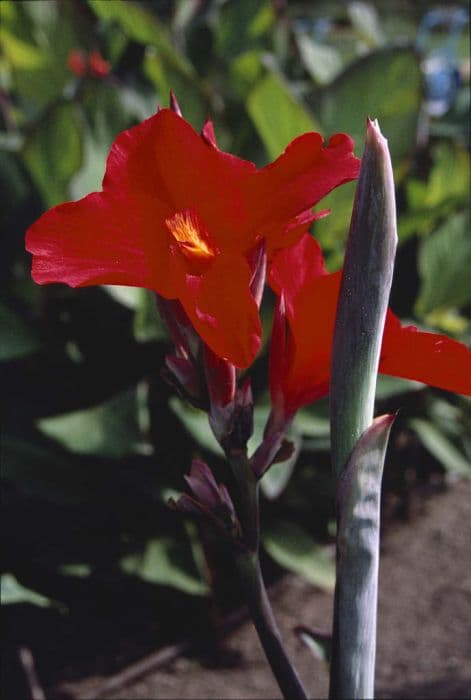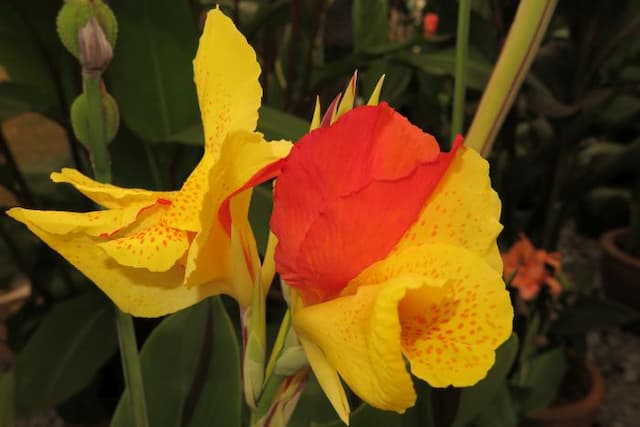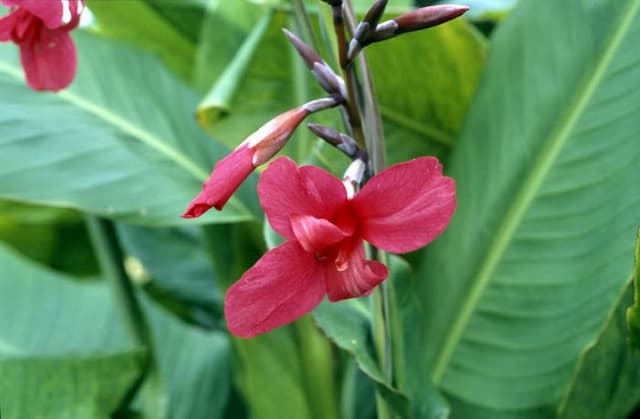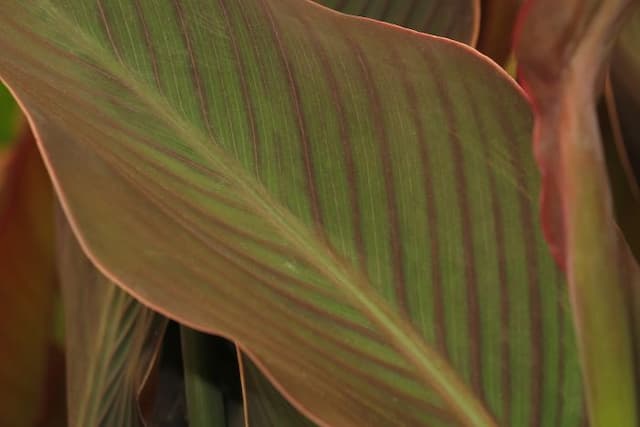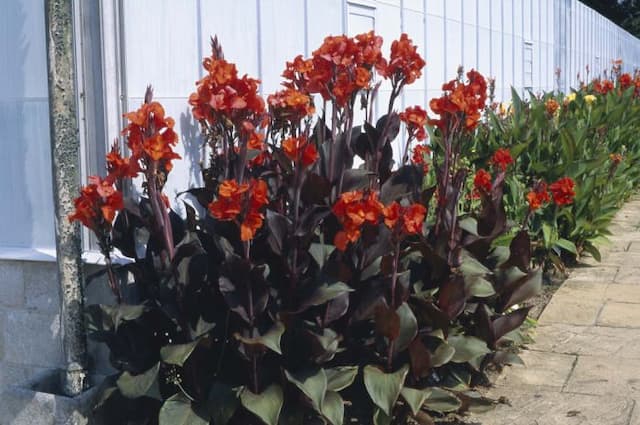Canna Lily Canna 'Happy Wilma' (Cannasol Series)

ABOUT
Canna 'Happy Wilma', from the Cannasol Series, is a vibrant and bold perennial known for its striking flowers and lush foliage. The flowers of this plant display vivid pink hues with a smooth, sometimes slightly ruffled texture. Each blossom unfurls in a classic canna shape, which is reminiscent of an iris, featuring larger outer petals that may curl gracefully back from the flower's center, exhibiting its stamen and pistil prominently. The foliage of Canna 'Happy Wilma' is equally attractive, with large, broad leaves that can have a tropical feel. The leaves are a rich green color, sometimes with a hint of blue-green, and they have a glossy sheen that catches the light. Some leaves may also have variegated or contrasting edges or streaks, adding further interest to the plant's overall appearance. As a member of the Cannasol Series, 'Happy Wilma' has been specifically bred for certain favorable attributes such as compact growth, long-lasting blooms, and disease resistance. This variety is appreciated for its ability to bring a touch of the tropics to gardens and landscapes with its flamboyant flowers and dramatic foliage. The plant grows from a rhizome, which allows it to emerge each year in regions where it can survive the winter months, or it can be replanted annually in cooler climates.
About this plant
 Names
NamesSynonyms
Garden Canna, Canna Lily, Indian Shot
Common names
Canna 'Happy Wilma'.
 Toxicity
ToxicityTo humans
Canna 'Happy Wilma' is a member of the canna lily family, which are not generally considered toxic to humans. However, as with many plants, it is still advisable not to consume any part of it, as there may be some risk of stomach upset or an allergic reaction in sensitive individuals. There are no well-documented cases of poisoning from eating canna lily, so the toxicity appears to be low. However, it is always better to err on the side of caution and prevent any accidental ingestion, especially in children.
To pets
Canna 'Happy Wilma', as a type of canna lily, is not listed as toxic to pets, such as dogs and cats, by major animal poison control resources. While it is not typically considered poisonous, ingestion of plant material could potentially cause mild gastrointestinal upset in some animals due to the presence of unknown irritants or from the simple act of eating non-digestible matter. If a pet ingests this plant and shows symptoms of distress, it is always best to consult with a veterinarian. Symptoms might include vomiting, diarrhea, or lethargy, but these are not specifically associated with canna lily ingestion and could result from eating a variety of inappropriate materials.
 Characteristics
CharacteristicsLife cycle
Perennials
Foliage type
Deciduous
Color of leaves
Green
Flower color
Pink
Height
2-3 feet (0.6-0.9 meters)
Spread
1-2 feet (0.3-0.6 meters)
Plant type
Bulb
Hardiness zones
7-10
Native area
South America
Benefits
 General Benefits
General Benefits- Low Maintenance: Canna 'Happy Wilma' is easy to care for, requiring minimal upkeep once established.
- Vibrant Flowering: It produces bright pink flowers that add a pop of color to any garden landscape.
- Attracts Pollinators: The flowers attract bees, butterflies, and hummingbirds, promoting biodiversity.
- Foliage Interest: Offers striking green foliage that provides a lush backdrop for the vibrant flowers.
- Disease Resistant: Bred to be resistant to common canna diseases, ensuring a healthier plant.
- Drought Tolerant: Once established, it can tolerate periods of dry weather, making it suitable for various climates.
- Fast Growing: Can quickly fill in garden spaces, providing immediate aesthetic impact.
- Adaptable: Versatile in its use, can be planted in borders, containers, or as a standalone feature.
- Long Blooming: Offers a long flowering season from early summer until the first frosts, providing lasting beauty.
- Deer Resistant: Not a preferred choice for deer, which can help reduce garden grazing damage.
 Medical Properties
Medical PropertiesThis plant is not used for medical purposes.
 Air-purifying Qualities
Air-purifying QualitiesThis plant is not specifically known for air purifying qualities.
 Other Uses
Other Uses- Canna 'Happy Wilma' can be used as a natural dye for fabrics and textiles, providing a range of pigments from the leaves and flowers.
- The fibers extracted from the stems of canna plants may be utilized in making paper, offering an alternative to traditional wood pulp.
- In some cultures, canna leaves are used in cooking as a wrapping material for certain foods, similar to banana leaves, for their flavor and ability to hold ingredients together during steaming.
- Cannas can be planted as a way to reclaim wet areas, as they can thrive in damp soil and help stabilize the ground.
- These plants are sometimes used in educational settings for botany studies due to their distinct morphology and rapid growth cycle.
- Canna 'Happy Wilma' can serve as a living fence or privacy screen due to its dense foliage.
- The large leaves of the canna plant can be used as a natural mulch in gardens, helping to suppress weeds and retain soil moisture.
- Canna seeds, which are hard and dense, have been used in jewelry making and as beads in various cultures.
- The sturdy stalks of canna plants can be used as stakes or trellises for supporting other plants in the garden.
- During off-seasons, dried canna stalks can be used creatively in arts and crafts for constructing decorative items or sculptures.
Interesting Facts
 Feng Shui
Feng ShuiThe Canna is not used in Feng Shui practice.
 Zodiac Sign Compitability
Zodiac Sign CompitabilityThe Canna is not used in astrology practice.
 Plant Symbolism
Plant Symbolism- Transformation - The Canna plant is often associated with change and transformation as it goes through a life cycle of growth, bloom, and renewal, thus reflecting the transformative nature of life.
- Prosperity - With its lush foliage and showy flowers, Cannas are often linked to abundance and prosperity, symbolizing the idea that one can flourish in their environment.
- Confidence - The bold and bright appearance of the Canna flower exudes confidence and can be symbolic of one's self-assuredness and pride.
- Beauty - Because of their striking appearance, Cannas embody beauty, reminding us to appreciate the aesthetic pleasures of the world.
 Water
WaterCannas require regular watering to maintain moist soil, especially during the growing season. For Canna 'Happy Wilma', water the plant with approximately 1 inch of water per week but adjust for rainfall accordingly; during hot, dry periods you may need to water more frequently. Allow the top inch of soil to dry out between watering to prevent overwatering. When you water, do so deeply to encourage root growth, but avoid letting the plant sit in standing water as this can promote root rot.
 Light
LightCanna plants, including 'Happy Wilma', thrive in full sun which means they need at least 6 hours of direct sunlight daily. Place them in a spot that receives bright and unfiltered sunlight for most of the day. They can tolerate some partial shade but will produce the best blooms and most vigorous growth in full sun conditions.
 Temperature
Temperature'Happy Wilma' canna plants are heat-loving and do best in temperatures between 60°F and 90°F. They can survive temporary dips down to about 50°F, but frost can be harmful. To ensure the most robust growth, aim to keep your canna in an environment that is consistently warm, avoiding any prolonged exposure to temperatures outside of their comfort zone.
 Pruning
PruningPrune your Canna 'Happy Wilma' to remove old flowers and encourage new blooms. Cut back spent flower stalks to the next side shoot to keep the plant tidy and promote continued blooming throughout the season. The best time for pruning is after a flower stalk has finished blooming, throughout the summer and into the fall.
 Cleaning
CleaningAs needed
 Soil
SoilCanna lilies thrive in a rich, well-draining soil mix with a pH between 6.0 and 6.5. A mix of garden soil, compost, and perlite or sand is ideal to ensure nutrients and proper drainage. Regular mulching helps retain moisture and keeps the soil healthy.
 Repotting
RepottingCanna lilies typically need repotting every couple of years or when they become root-bound. It's best to repot in the spring before the growing season begins, allowing the plant to establish in its new container.
 Humidity & Misting
Humidity & MistingCanna lilies prefer a moderate to high humidity level but are quite adaptable to typical outdoor humidity conditions. They can tolerate humidity levels between 50% to 70%.
 Suitable locations
Suitable locationsIndoor
Place in bright, indirect light and keep soil moist.
Outdoor
Plant in full sun, moist soil, and protect from frost.
Hardiness zone
7-11 USDA
 Life cycle
Life cycleCanna 'Happy Wilma' begins its life as a rhizome, which, when planted in spring after the last frost, will sprout into a small shoot. As the growing season progresses, the shoot develops into a lush foliage plant with large leaves, eventually reaching its mature size. During the summer, the Canna 'Happy Wilma' produces vibrant, colorful flowers that attract pollinators and add aesthetic beauty to gardens. After blooming, if pollinated, the flowers may produce seed pods, although many cultivated varieties are sterile. As fall approaches and temperatures drop, the plant's growth slows and the foliage begins to die back, signaling the end of the growing season. With the first frost, the plant enters dormancy, where the rhizome survives underground through winter, ready to regenerate the following spring.
 Propogation
PropogationPropogation time
Spring-Early Summer
The Canna 'Happy Wilma', which is part of the Cannasol Series, is predominantly propagated through division. The best time to propagate canna lilies is in the spring when new growth emerges. To propagate by division, gardeners should first gently lift the canna clump out of the ground using a garden fork, then carefully separate the rhizomes, ensuring that each division has at least one eye, which is a growth point. These divisions can then be replanted into well-draining soil at a depth of about 4 to 5 inches (approximately 10 to 12.7 centimeters), spaced about 18 to 24 inches (roughly 45.7 to 61 centimeters) apart, with eyes facing upwards. Given proper care, they will grow into full plants and flower in the following season.

